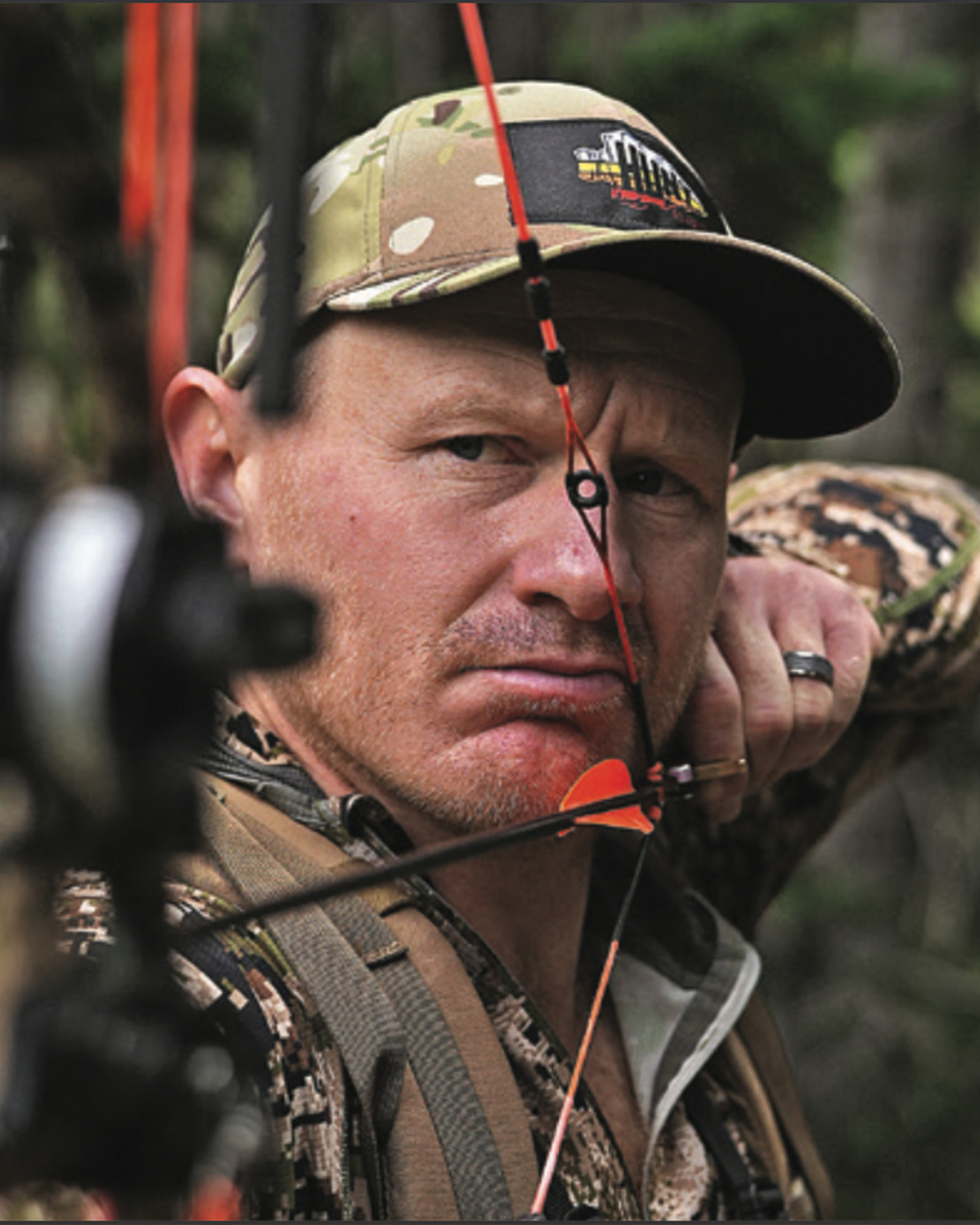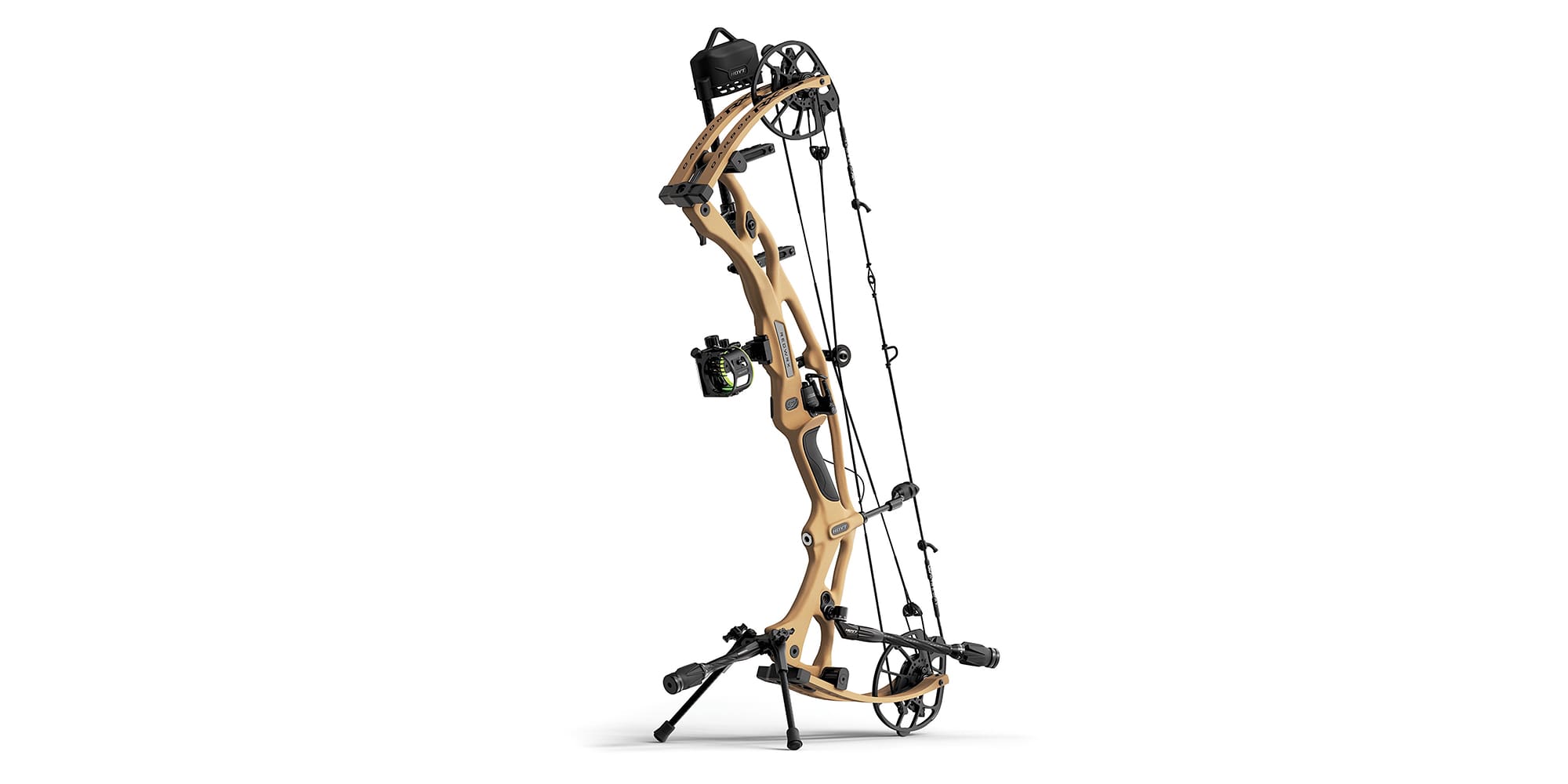
NOTICE: Certain links on this post may earn a commission for Western Hunter Magazine from Amazon or our other affiliate partners when you make a purchase. Thank you for your support.
Hoyt RX-9 Bow Review
If you are like me, Christmas Day isn’t December 25th, it’s the day you get your new bow! This year I picked up the new Hoyt RX-9 and I absolutely love it. It’s the new flagship carbon bow from Hoyt for 2025. In this article, I am going to discuss what I love about this bow and what I look for in a bow in general. I’m not saying that it’s necessary to buy a new bow every single year. After all, if you find something that works, why screw with success? But it may be worth a look every few years to see what’s available. Like anything, there are a lot of user preferences when selecting a bow, but this article will at least serve as a guide for things to consider before purchasing.
Why I Love Carbon
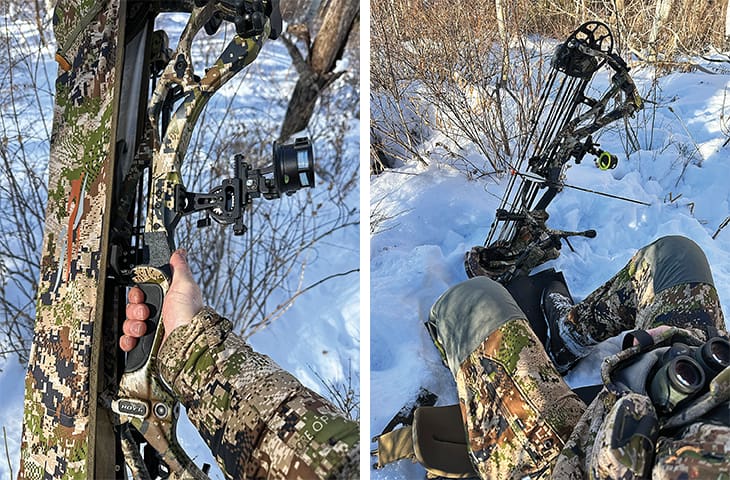
One of the first things I consider when purchasing a bow is the material of construction. There are a few different bow materials out there; different grades of aluminum, magnesium, and carbon. I’m going to come right out and say it: I have a strong preference for carbon bows, and it’s not for the reason that you probably think. I don’t get caught up in the weight of a bow, and that’s not why I prefer carbon; I prefer carbon bows because they are “warm to the touch.”
Just as metals conduct electricity, they conduct heat; heat flows from hot to cold. This means when it is cold outside (difference between your body temperature and the outdoor temperature), a metal bow will pull heat out of your body quickly and transfer it to the surroundings. Most bows are made out of aluminum, and aluminum has a very high thermal conductivity, which means it’s a highway for transferring (flowing) heat quickly.
Hunting in the mountains into December, I have literally sustained cold burns on my hand from gripping an aluminum bow. I refuse to shoot my bow with gloves on, so that is not a solution for me. Beyond the cold burns, even with a glove on, you can feel the heat flowing out of you when walking around all day holding a piece of aluminum.
Contrast that with a carbon bow. Carbon has a low thermal conductivity, which means it does not transfer (flow) heat effectively. This means that the bow does not feel cold to the touch in the winter, and it is very noticeable when you are walking around holding your bow all day. Trust me, I do a ton of bow hunting in November and December, and it’s just a chore staying warm in the mountains in the late season with all the wind, cold, and snow. So, the advantage of a carbon bow is a big deal.
For you ounce counters, carbon bows are generally a half-pound to a full pound lighter than equivalent aluminum bows. I won’t deny this is advantageous when hiking up and down steep mountains all day, but it’s not the primary reason why I prefer carbon.
Quite a few bow manufacturers are offering carbon bows now, but only Hoyt has any real history with it. Hoyt has perfected the carbon riser in the RX-9 with over 15 years of experience building carbon risers pouring into this bow. Carbon bows I have shot from other brands are plagued by excessive shot vibration and noise. They are getting better, no doubt, but they are nowhere near what a Hoyt carbon is. The RX-9 is the quietest, most dead-in-the-hand carbon bow I have ever shot. Hoyt is the king of carbon.
Axle to Axle Length
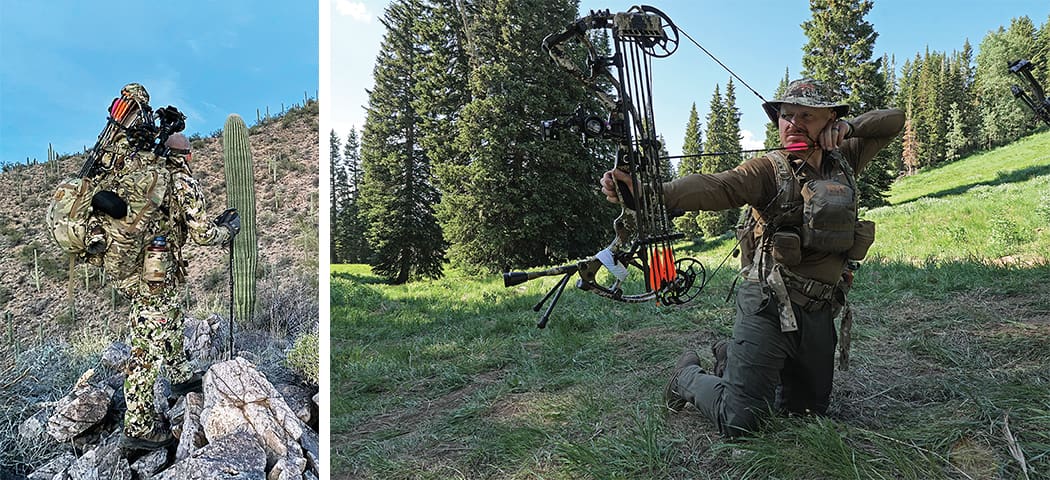
Right: Shorter ATA bows have an advantage in shooting from the knees as well, especially if you are shooting in an area with taller ground vegetation.
Another major consideration is bow axle-to-axle (ATA) length. Longer ATA promotes better accuracy but can be cumbersome to carry in the hills. Your draw length should also factor into choosing the ATA of your bow. Draw length and ATA length combine to affect string angle. String angle is a very important consideration to promote good archery form and accuracy.
For the most part, string angle steepens as draw length increases and/or ATA length decreases. A steeper string angle is less desirable because it will mess with your anchor point. It’ll require you to lean your head forward in order to get your nose to touch the string, which promotes bad shooting posture. If you don’t lean your head forward, you will lose the secondary anchor point of the string on the tip of your nose.
For my body size and a draw length of 28”, my ideal ATA length is 30”-32”. At this length, my string angle is nearly perfect, the bow is lighter, more maneuverable, has good clearance when strapping to a backpack (where my bow lives 90% of the time), and has decent stability.
ATA length will influence a bow’s forgiveness/stability. The longer the ATA length, the more forgiving the bow is at the shot. This is because the bow’s moment of inertia increases with ATA length. Moment of inertia is the measure of an object’s resistance to angular acceleration/movement about an axis (bow grip). This means that the pin float on target (micro-movements at full draw) decreases as ATA length increases. This is the reason that most target bows have a longer ATA length.
For hunting, there is a balance between maneuverability and stability that will vary for every person. The one year I had a 35” ATA bow, I hated how tall it was on my backpack when riding my e-bike, riding a horse, or backpacking in, so longer isn’t necessarily better. If you do a lot of backpack, horseback, or bike-pack hunting in the mountains, I’d recommend a shorter ATA bow. Conversely, if you hunt foothills, desert flats, or prairies out of a truck or side-by-side, the forgiveness of a longer ATA bow can be beneficial.
To help dial in a great fit for a wide variety of archers, for 2025 Hoyt offers a wide variety of ATA lengths in their lineup: carbons bows at 30” and 34” and aluminum bows at 29”, 32”, and 36”. I’ve shot the 30” ATA Hoyt carbon bow for many years and it’s the perfect combination of maneuverability and stability for me.
Drivetrain
The drivetrain is the motive force of the bow, which consists of the limbs, the cams, and the bow’s power stroke. Power stroke is simply the distance the arrow remains on the bow string when the bow is cycled. It is essentially the draw length minus the brace height. The longer the power stroke, the more potential energy in the bow. For a given archer, their draw length remains constant, so to increase power stroke, an archer would select a bow with a shorter brace height. Don’t get carried away with this, however.
Decreasing brace height is a double-edged sword. Decreasing brace height will, in general, decrease a bow’s forgiveness. Decreasing brace height too much can also lead to the string making contact with the clothes on your bow arm. For me, a brace height of around 6.25” is a good balance of performance and forgiveness at my 28” draw length. The RX-9 has a brace height of 6.125”, which is just about perfect for me. The longer your draw length, the more you should consider a longer brace height.
At the heart of a bow’s drivetrain is the cam system. The cam dictates how the bow draws, how it holds, and how efficient the bow is. The cams from each bow manufacturer all have a different “feel.” From the moment you start to draw a bow, the force to draw increases until you hit the maximum draw force. As you continue to draw, the force to draw decreases due to let off until the minimum draw force point, “the valley.” After the cam rolls completely over, the draw force just begins to increase again right before you hit the back wall.
A couple of things I look for are how quickly the bow builds to maximum draw weight, how gradually it lets off to the valley, and how forgiving and firm the back wall feels. A firm back wall promotes better shot execution for me. Sometimes people use the word “smooth” to describe the draw cycle of a bow. What this means to me is a consistent and gradual draw force throughout the draw cycle. This means the draw force gradually builds to maximum draw weight, then gradually decreases to the valley. A bow with a smooth draw cycle feels “easier” to draw than the peak draw weight would suggest.
A more aggressive cam will build sharply to maximum draw force, remain at that draw force for the majority of the draw cycle, and then dump draw force rapidly to the valley. These types of cams feel harder to draw and jerky, and you tend to hit the back wall really hard because you go from peak draw force to minimum draw force so quickly.
Since these types of cams have very little valley, they can feel very “jumpy,” meaning that if you creep forward at all at full draw, the bow will jerk forward into firing because the maximum draw force sits so closely to the minimum draw force. The benefit of these types of cams is the bow speeds they produce. If you have a shorter draw length or shoot low poundage, you should consider a bow with a more aggressive cam.
The draw cycle is one thing that Hoyt has knocked out of the park with the cam system on the RX-9. It is the fourth generation of the HBX cam. It has a modest and very smooth draw cycle, building gradually to peak draw force and then letting down gradually to the valley. The transition on the back end from the valley to the back wall is excellent. There is no perceived hump, and the back wall is as firm as I have ever felt from a cable stop (this cam actually gives you two back wall adjustment settings so you can choose the firmness you prefer). Best of all, the 2025 HBX cam draws very easily. My 80-lb RX-9 draws like a 70-lb bow from other manufacturers. It is obvious that Hoyt has spent a lot of time and money developing these cams because they are so smooth and very efficient.
Cam Efficiency
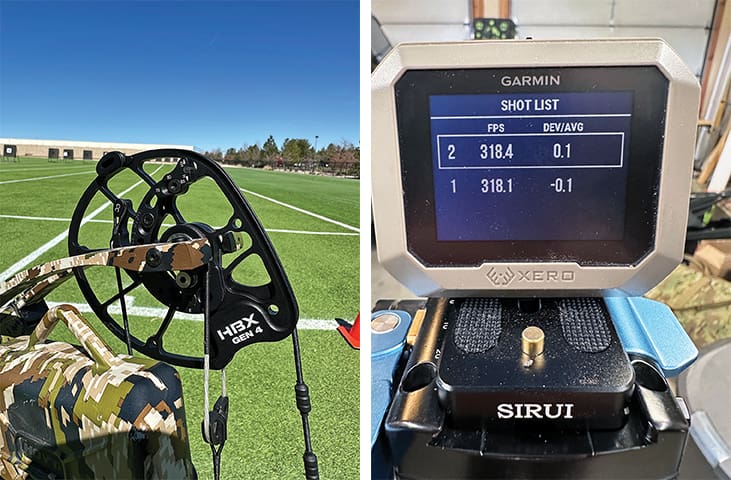
Right: My Hoyt RX-9 at 82# and a draw length of 28” is shooting a 422-grain arrow at 318 FPS!
There is a lot that goes into cam efficiency, but one aspect that can really impact the shooter is the cam mod position for your draw length on the adjustable cam module. Cams with adjustable draw length modules are most efficient at the max draw length (top of the cam/module). Cams that have a rotating module that spans many inches of draw length can be extremely inefficient.
For one, the rotating mods that span many inches tend to be bigger and heavier, which reduces the rotational velocity of the cam. Secondly, the cam is generally optimized for the maximum draw length, and each shorter draw length takes a hit in efficiency. The alternative to this is designing a cam or a mod for each individual draw length or shorter draw length spans. This means that the cam system will be more efficient at every individual draw length.
Hoyt understands this issue better than most, and for 2025, the 4th gen HBX cam modules have one-inch draw length spans. Instead of offering one or two mods to span the entire draw length range on the RX-9 from 25-30”, Hoyt offers five different modules. Each module has quarter-inch draw length adjustments. This is a very big deal, allowing all draw length positions on the mods to be efficient.
On the RX-9 Ultra, Hoyt is seeing speed gains of nearly 20 FPS for some draw lengths compared to last year’s bow. I’m seeing the efficiency gained by the new cam in my own bow. My RX-9 is set at 82 lb and 28” draw length and is slinging a 422-grain arrow at 318 FPS. Also, good news for any of you short-draw people; Hoyt is now offering a short-draw version of the RX-9 that is optimized for 23”-27” draw lengths.
A note about bow draw weight: Don’t over-bow yourself simply because you are mesmerized by the performance of an 80-pound bow. Shoot as much draw weight as you can comfortably and accurately shoot. Also, consider how much time you are able to shoot in terms of number of reps. There is no better exercise to strengthen your shooting muscles than just shooting your bow.
I am a big believer in high reps to build strength and muscle memory. If you don’t have a lot of time to shoot and maintain strength, an 80-pound bow is probably a poor choice. I’ve heard it said that you should be able to comfortably draw (no sky draw, bow arm parallel to the ground) when seated flat on your butt with your legs straight out in front of you. If you struggle to do this, you are drawing too much weight.
Geometry and Accessories
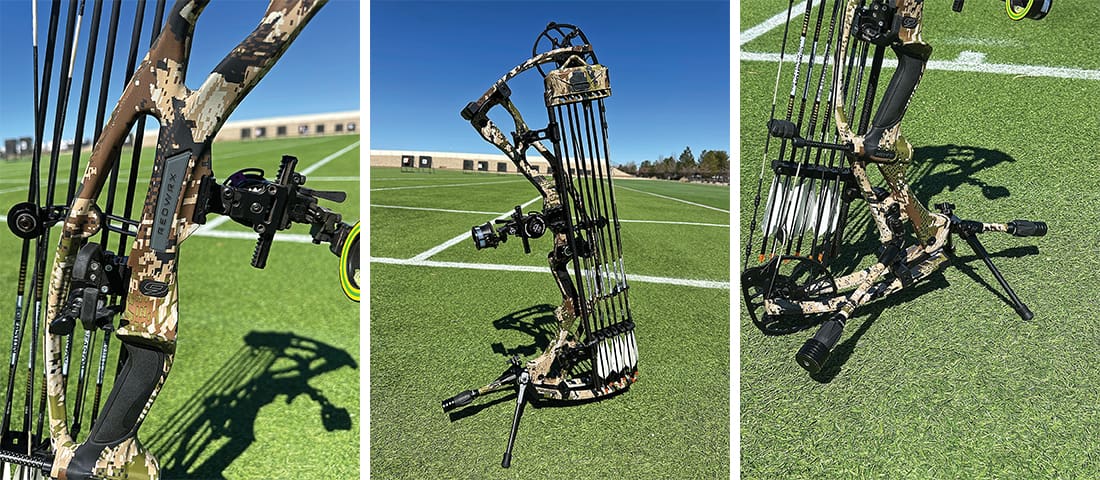
Center: Hoyt’s line of quivers integrates extremely well into the bow. I like the Carbon Superlite Stretch Quiver because it mounts to the riser in two places and fits very tightly to the riser. This promotes excellent bow balance.
Right: Hoyt has done an excellent job of getting the stabilizer mounts as low as possible on the bow, which again promotes excellent bow balance. Better bow balance equates to less pin float at full draw.
A couple of geometry details that I continue to love about Hoyt bows that are continued on the RX-9: I love Hoyt’s tec riser. On the riser, this is the bridge that goes around the grip, connecting below and above the grip. This is a major structural member of the bow’s riser. It adds rigidity, making the riser less prone to twisting, which increases repeatability. It also helps reduce shot vibration at the grip. The other geometry detail that I love is the lower stabilizer mounts that Hoyt has been producing for the last few years. Since the stabilizer mounts are so low, it dramatically lowers the center of gravity of the bow, which means more stability (less pin float) while aiming.
Lastly, I’ve come to really appreciate bow accessories that are well thought out and integrate into the bow to promote better balance and stability. Hoyt released the In-line Accessory System a couple of years ago with the Picatinny-rail sight attachment and new ultra-low-profile quivers. Bow balance is not a minor thing; it means better accuracy and a lighter-weight bow because you can reduce stabilizer weight! If you don’t believe me, I encourage you to go shoot a new Hoyt that is fully set up with the new in-line accessories, and you will immediately feel the balance difference.
Conclusion
There is a lot to think about when it comes to purchasing a new bow. Think about a bow as a group of features, and all of those individual features add up to be the entire bow. I believe that if you take time to think about the features that you want in a bow and then go out and find the bow that has the best combination of those features, it’ll make you more deadly in the field.
The whole intent of a hunt is to kill an animal, and for that reason, weapon optimization should be a paramount step in your overall process. I believe every bow manufacturer is making amazing flagship bows these days. Fundamentally, any one of them will kill an animal. I think the most important thing is to find the bow that has the best combination of features and attributes that best fits your needs and your hunting style. Undeniably, the Hoyt RX-9 has the best combination of features to suit my needs and hunting style!


